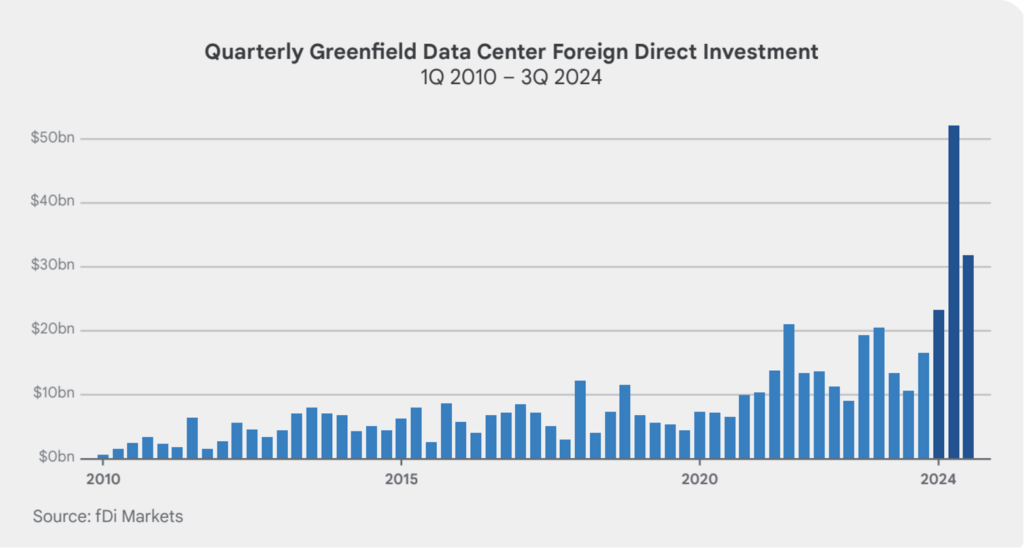How governments are driving AI adoption for economic growth

Around the world, policymakers are recognising artificial intelligence’s immense potential to reshape economies, transform industries, and strengthen global competitiveness.
While generative AI chatbots and image generators have captured the public’s attention, these tools are just a fraction of the sweeping economic transformation AI is poised to catalyse through increasing labour productivity, improving public services, and accelerating scientific progress.
However, realising these benefits demands not only continued technological advancement but also widespread adoption and adaptation across all sectors of the economy. History suggests that countries that gain the most from innovation are not necessarily those that invent technologies first, but rather those that deploy them most effectively.
Today, nearly 70 countries have adopted national AI strategies and policies. While many are still in the early stages of translating these strategies into action, a select group are emerging as AI Pioneers, moving beyond policy blueprints to make tangible investments in AI development and adoption. Google’s newly released report, AI Pioneers: How Countries are Seizing the AI Opportunity, delves into how leading countries are navigating this pivotal moment.
The report explores how countries are accelerating AI adoption by building across the three pillars of an AI Opportunity Agenda: (1) building robust AI infrastructure; (2) developing a skilled workforce; and (3) fostering a supportive policy framework. Progress across all three is essential for attracting the investments needed to build the technical foundation for broad AI adoption.
Pillar 1: Building AI infrastructure
Just as past economic revolutions relied on foundational infrastructure – canals, railways, or electricity grids – the AI era demands a new digital and physical backbone. This means investing in the infrastructure that powers AI development and deployment: high-speed internet, data centres and systems, and new energy solutions.
- Embracing cloud-first policies. Cloud computing provides an essential foundation for harnessing AI’s power. Its vast computational resources, scalable data storage, and advanced data management and analysis capabilities are crucial for AI applications. Governments are directing public sector agencies to prioritise cloud-based IT infrastructure and services over on-premise solutions, recognising the cloud’s fundamental role in enabling AI capabilities.
- Attracting investment in new data centres and cloud regions. McKinsey projects that global demand for data centre capacity will more than triple by 2030, primarily fuelled by AI. Governments are implementing a range of approaches to encourage this vital infrastructure investment, including streamlining approval processes, creating incentives for renewable energy, and offering tax exemptions.
- Strengthening connectivity: Alongside data centres, robust connectivity through subsea and terrestrial cables is essential for the fast and reliable data transfers needed to support AI applications. Initiatives like Google’s Pacific Connect and Africa Connect are examples of private sector efforts to build this global connectivity, linking continents and facilitating the flow of data necessary for AI training and deployment.
- Unlocking energy solutions. Powering AI demands significant energy. Collaboration between government and industry is key to expanding electricity infrastructure capacity, which can drive economic growth and competitiveness while helping to meet decarbonisation goals. Several governments are liberalising their electricity markets to reduce costs, enhance reliability, and facilitate the interconnection of new clean energy resources.
- Ensuring security and resilience. Governments are establishing partnerships with tech companies and security experts to safeguard AI systems from cyberattacks and equip critical infrastructure defenders with cutting-edge AI tools to support their mission.
Pillar 2: Developing a skilled workforce
Building an AI-ready workforce requires a collaborative effort from governments, the private sector, and educational institutions. This will require cultivating AI fluency in three areas: (1) ensuring foundational AI skills for all workers and students; (2) enabling governments, traditional industries, and small businesses to use and adapt AI tools effectively; and (3) developing the deep technical expertise needed to advance AI technology and shape its evolution. Over the past year, some countries have taken important steps in this direction:
- Leading by example through government adoption: Governments are setting a precedent by ensuring public sector workers gain essential AI skills and deploying AI tools across diverse government functions and public service use cases.
- Integrating AI literacy into primary education. Many governments are integrating AI literacy and critical thinking into school curricula and scaling personalised learning initiatives using AI.
- Incorporating AI curriculum at universities. To meet rising demand for AI expertise, universities in some countries are expanding AI programmes, often partnering with the private sector to develop specialised curricula.
- Developing certified credentials for AI skills. As technological change accelerates, it will become more important for people to learn skills quickly and earn well-recognised credentials. Through the Career Certificates programme, Google is boosting on-demand training for in-demand tech skills globally, collaborating with governments and more than 550 universities across Latin America to offer a continuously updated portfolio of learning resources to ensure students are ready to seize the opportunities created by new technologies.
- Empowering SMEs with AI: Governments are establishing platforms and programmes to help small and medium-sized enterprises (SMEs) explore AI use cases, test applications, and create internal AI talent.
Pillar 3: Fostering a supportive policy framework
A supportive policy environment is critical to AI innovation and investment. Governments seek to prevent AI’s misuse, but they must also guard against “missed uses,” or lost opportunities to use AI for significant social and economic benefit. Policymakers can balance both goals and encourage responsible innovation by avoiding actions that could stifle innovation, create barriers for startups, slow R&D, or hinder AI’s potential to address major challenges in areas such as healthcare and climate change.
- Risk-based approaches to AI. Many jurisdictions are adopting risk-based approaches to AI, recognising that policies should be calibrated to the specific risks associated with different AI applications, while also considering the opportunity costs of not deploying AI for societal benefit.
- Codes of conduct and guidelines. A growing number of economies publish codes of conduct, principles, and standards to promote responsible AI use across supply chains and commercial ecosystems. They provide developers with crucial guidance while remaining flexible in a rapidly evolving technological landscape.
- Fair use and text & data mining (TDM) exceptions: Several jurisdictions, including the US, Israel, Japan, Singapore, and the EU have recognised the importance of copyright frameworks that allow for the use of protected material by researchers and innovators under certain circumstances – often referred to as limitations and exceptions – without requiring permission from the copyright holder.
- Competitiveness Assessments. To maximise AI’s potential, many governments are actively evaluating and calibrating their regulatory frameworks to attract investment and weigh the impact of regulation on economic competitiveness.
Attracting AI Investment
Making progress on all three pillars is essential for attracting the investments needed to build the technical foundation for broad AI adoption. Attracting foreign direct investment (FDI) is particularly crucial for countries that lack the capital or technical expertise necessary to develop AI infrastructure independently.
Over the past five years, foreign direct investment (FDI) in AI infrastructure has surged globally, despite overall FDI remaining sluggish. In 2024, greenfield FDI in data centres reached $144 billion, about 9% of total global FDI. These investments increasingly flow beyond traditional investment hubs to emerging markets and regions like Northumberland in the UK and the US Rust Belt.
While not every country needs its own dedicated data centre to harness the benefits of AI, investment in data centres can spark local economic development in areas like network infrastructure, specialised manufacturing (e.g., server hardware), and the expansion of energy capacity.
Many data centre projects incorporate training programmes to help local communities acquire the skills needed to work with advanced technologies. For example, Google’s most recent data centre investments in Mexico, Uruguay, Thailand, South Africa, and Malaysia all involve training programmes in partnership with local education institutions and training centres.
Countries with a strong business climate and reliable institutions typically attract higher levels of Foreign Direct Investment (FDI). This is especially true for AI infrastructure, which involves large, immovable assets. Companies searching for investment opportunities gravitate toward countries with policies that encourage innovation, offer clear and predictable tax policies, and provide reliable, cost-effective energy solutions — all crucial factors in creating a favourable environment for technology advancement.
Charting the Course for AI Prosperity

By cultivating an ecosystem where businesses can confidently invest, innovate, and partner, governments that build across the three AI Opportunity pillars can catalyse the rapid development and adoption of AI. Ultimately, these efforts will determine which societies reap the benefits from this transformational technology.


































